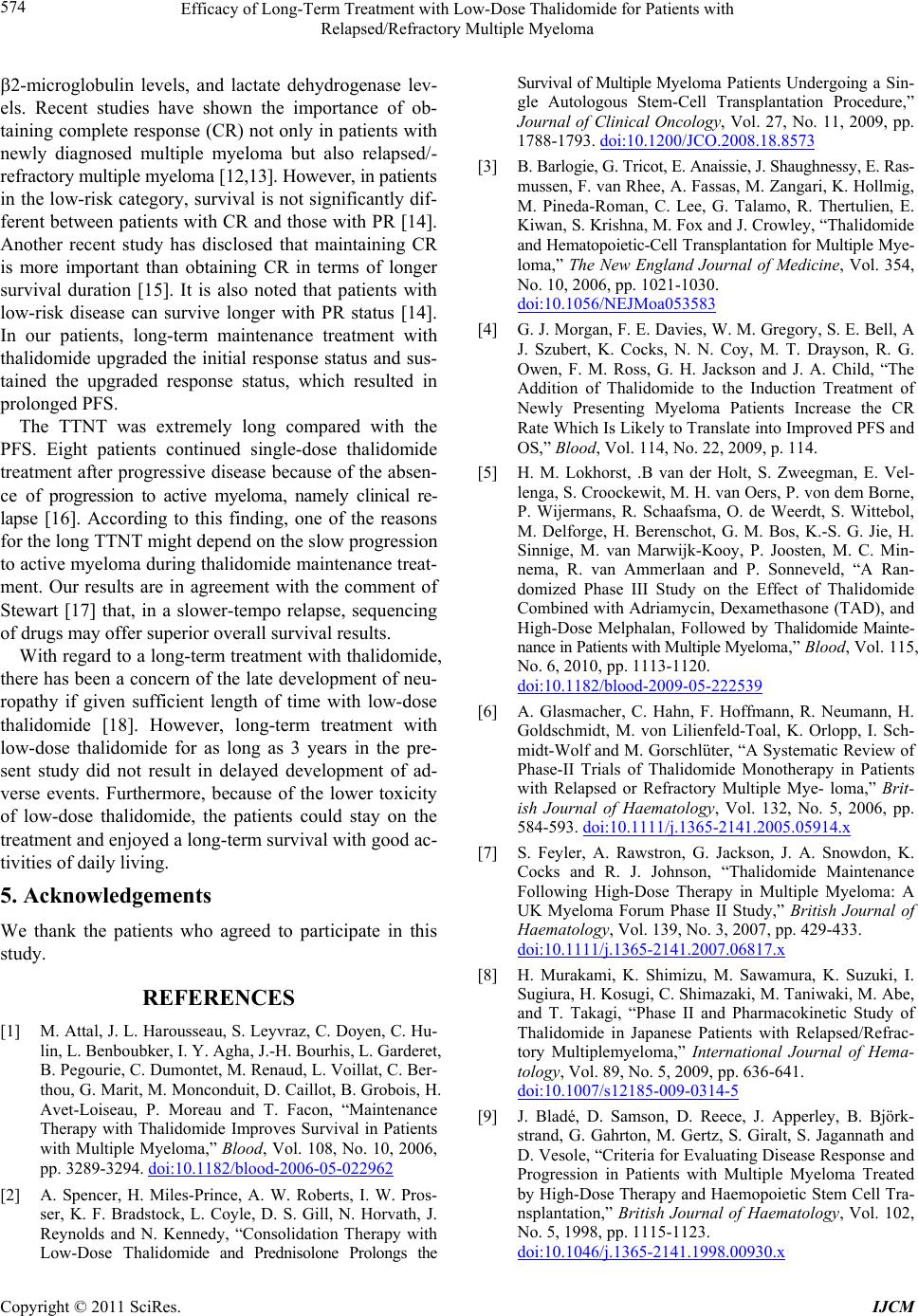
Efficacy of Long-Term Treatment with Low-Dose Thalidomide for Patients with
574
Relapsed/Refractory Multiple Myeloma
2-microglobulin levels, and lactate dehydrogenase lev-
els. Recent studies have shown the importance of ob-
taining complete response (CR) not only in patients with
newly diagnosed multiple myeloma but also relapsed/-
refractory multiple myeloma [12,13]. However, in patients
in the low-risk category, survival is not significantly dif-
ferent between patients with CR and those with PR [14].
Another recent study has disclosed that maintaining CR
is more important than obtaining CR in terms of longer
survival duration [15]. It is also noted that patients with
low-risk disease can survive longer with PR status [14].
In our patients, long-term maintenance treatment with
thalidomide upgraded the initial response status and sus-
tained the upgraded response status, which resulted in
prolonged PFS.
The TTNT was extremely long compared with the
PFS. Eight patients continued single-dose thalidomide
treatment after progressive disease because of the absen-
ce of progression to active myeloma, namely clinical re-
lapse [16]. According to this finding, one of the reasons
for the long TTNT might depend on the slow progression
to active myeloma during thalidomide maintenance treat-
ment. Our results are in agreement with the comment of
Stewart [17] that, in a slower-tempo relapse, sequencing
of drugs may offer superior overall survival results.
With regard to a long-term treatment with thalidomide,
there has been a concern of the late development of neu-
ropathy if given sufficient length of time with low-dose
thalidomide [18]. However, long-term treatment with
low-dose thalidomide for as long as 3 years in the pre-
sent study did not result in delayed development of ad-
verse events. Furthermore, because of the lower toxicity
of low-dose thalidomide, the patients could stay on the
treatment and enjoyed a long-term survival with good ac-
tivities of daily living.
5. Acknowledgements
We thank the patients who agreed to participate in this
study.
REFERENCES
[1] M. Attal, J. L. Harousseau, S. Leyvraz, C. Doyen, C. Hu-
lin, L. Benboubker, I. Y. Agha, J.-H. Bourhis, L. Garderet,
B. Pegourie, C. Dumontet, M. Renaud, L. Voillat, C. Ber-
thou, G. Marit, M. Monconduit, D. Caillot, B. Grobois, H.
Avet-Loiseau, P. Moreau and T. Facon, “Maintenance
Therapy with Thalidomide Improves Survival in Patients
with Multiple Myeloma,” Blood, Vol. 108, No. 10, 2006,
pp. 3289-3294. doi:10.1182/blood-2006-05-022962
[2] A. Spencer, H. Miles-Prince, A. W. Roberts, I. W. Pros-
ser, K. F. Bradstock, L. Coyle, D. S. Gill, N. Horvath, J.
Reynolds and N. Kennedy, “Consolidation Therapy with
Low-Dose Thalidomide and Prednisolone Prolongs the
Survival of Multiple Myeloma Patients Undergoing a Sin-
gle Autologous Stem-Cell Transplantation Procedure,”
Journal of Clinical Oncology, Vol. 27, No. 11, 2009, pp.
1788-1793. doi:10.1200/JCO.2008.18.8573
[3] B. Barlogie, G. Tricot, E. Anaissie, J. Shaughnessy, E. Ras-
mussen, F. van Rhee, A. Fassas, M. Zangari, K. Hollmig,
M. Pineda-Roman, C. Lee, G. Talamo, R. Thertulien, E.
Kiwan, S. Krishna, M. Fox and J. Crowley, “Thalidomide
and Hematopoietic-Cell Transplantation for Multiple Mye-
loma,” The New England Journal of Medicine, Vol. 354,
No. 10, 2006, pp. 1021-1030.
doi:10.1056/NEJMoa053583
[4] G. J. Morgan, F. E. Davies, W. M. Gregory, S. E. Bell, A
J. Szubert, K. Cocks, N. N. Coy, M. T. Drayson, R. G.
Owen, F. M. Ross, G. H. Jackson and J. A. Child, “The
Addition of Thalidomide to the Induction Treatment of
Newly Presenting Myeloma Patients Increase the CR
Rate Which Is Likely to Translate into Improved PFS and
OS,” Blood, Vol. 114, No. 22, 2009, p. 114.
[5] H. M. Lokhorst, .B van der Holt, S. Zweegman, E. Vel-
lenga, S. Croockewit, M. H. van Oers, P. von dem Borne,
P. Wijermans, R. Schaafsma, O. de Weerdt, S. Wittebol,
M. Delforge, H. Berenschot, G. M. Bos, K.-S. G. Jie, H.
Sinnige, M. van Marwijk-Kooy, P. Joosten, M. C. Min-
nema, R. van Ammerlaan and P. Sonneveld, “A Ran-
domized Phase III Study on the Effect of Thalidomide
Combined with Adriamycin, Dexamethasone (TAD), and
High-Dose Melphalan, Followed by Thalidomide Mainte-
nance in Patients with Multiple Myeloma,” Blood, Vol. 115,
No. 6, 2010, pp. 1113-1120.
doi:10.1182/blood-2009-05-222539
[6] A. Glasmacher, C. Hahn, F. Hoffmann, R. Neumann, H.
Goldschmidt, M. von Lilienfeld-Toal, K. Orlopp, I. Sch-
midt-Wolf and M. Gorschlüter, “A Systematic Review of
Phase-II Trials of Thalidomide Monotherapy in Patients
with Relapsed or Refractory Multiple Mye- loma,” Brit-
ish Journal of Haematology, Vol. 132, No. 5, 2006, pp.
584-593. doi:10.1111/j.1365-2141.2005.05914.x
[7] S. Feyler, A. Rawstron, G. Jackson, J. A. Snowdon, K.
Cocks and R. J. Johnson, “Thalidomide Maintenance
Following High-Dose Therapy in Multiple Myeloma: A
UK Myeloma Forum Phase II Study,” British Journal of
Haematology, Vol. 139, No. 3, 2007, pp. 429-433.
doi:10.1111/j.1365-2141.2007.06817.x
[8] H. Murakami, K. Shimizu, M. Sawamura, K. Suzuki, I.
Sugiura, H. Kosugi, C. Shimazaki, M. Taniwaki, M. Abe,
and T. Takagi, “Phase II and Pharmacokinetic Study of
Thalidomide in Japanese Patients with Relapsed/Refrac-
tory Multiplemyeloma,” International Journal of Hema-
tology, Vol. 89, No. 5, 2009, pp. 636-641.
doi:10.1007/s12185-009-0314-5
[9] J. Bladé, D. Samson, D. Reece, J. Apperley, B. Björk-
strand, G. Gahrton, M. Gertz, S. Giralt, S. Jagannath and
D. Vesole, “Criteria for Evaluating Disease Response and
Progression in Patients with Multiple Myeloma Treated
by High-Dose Therapy and Haemopoietic Stem Cell Tra-
nsplantation,” British Journal of Haematology, Vol. 102,
No. 5, 1998, pp. 1115-1123.
doi:10.1046/j.1365-2141.1998.00930.x
Copyright © 2011 SciRes. IJCM